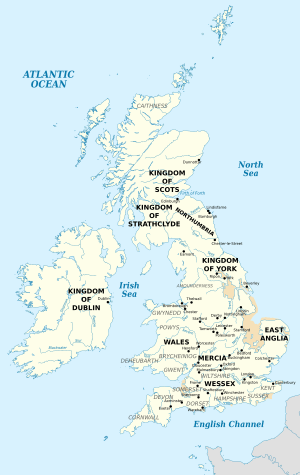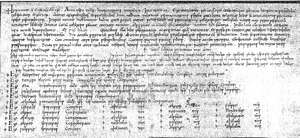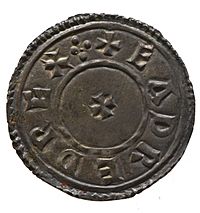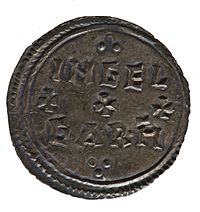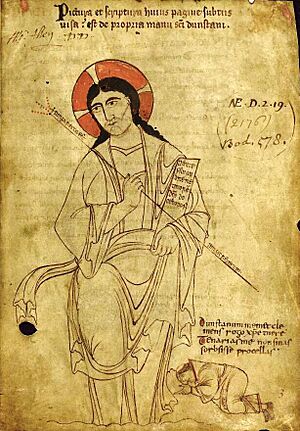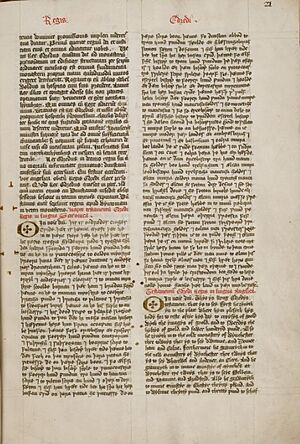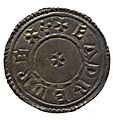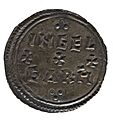Eadred facts for kids
Quick facts for kids Eadred |
|
|---|---|
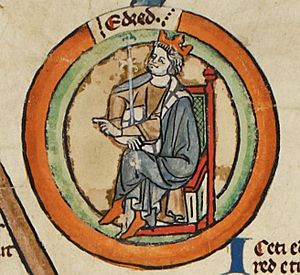
Eadred in the early fourteenth-century Genealogical Roll of the Kings of England
|
|
| King of the English | |
| Reign | 26 May 946 – 23 November 955 |
| Coronation | 16 August 946 Kingston upon Thames |
| Predecessor | Edmund I |
| Successor | Eadwig |
| Born | c. 923 Wessex |
| Died | 23 November 955 (aged c. 32) Frome, Somerset |
| Burial | Old Minster, Winchester. Bones now in Winchester Cathedral |
| House | Wessex |
| Father | Edward the Elder |
| Mother | Eadgifu |
Eadred (born around 923 – died November 23, 955) was the King of the English from May 26, 946, until his death. He was a younger son of Edward the Elder and his third wife, Eadgifu. He was also a grandson of Alfred the Great.
Eadred became king because his older brother, Edmund, was killed. Edmund's two sons, Eadwig and Edgar, were very young children at the time. Eadred suffered from poor health in his later years. He died when he was about 32 years old and never married. His nephews, Eadwig and Edgar, became kings after him.
Eadred's half-brother, Æthelstan, became king of England south of the Humber in 924. He then conquered the Viking kingdom of York in 927. Both Edmund and Eadred inherited the rule of the whole kingdom. However, they lost control of York when it accepted Viking kings. They both managed to get it back by the end of their reigns. In 954, the leaders in York kicked out their last Viking king, Erik Bloodaxe. Eadred then made Osulf, an Anglo-Saxon ruler, the first main leader (called an ealdorman) of all of Northumbria.
Eadred was very close to his brother Edmund. He kept many of Edmund's main advisors. These included his mother Eadgifu, Oda, Archbishop of Canterbury, and Æthelstan, the ealdorman of East Anglia. Æthelstan was so powerful that people called him the 'Half-King'. Dunstan, who was the Abbot of Glastonbury and later became Archbishop of Canterbury, was also a close friend and advisor. Eadred allowed Dunstan to write official documents (called charters) when he became too sick to attend meetings of the witan (the King's Council).
Eadred strongly supported the early stages of the English Benedictine Reform. This was a movement to improve monasteries. He was close to two of its leaders: Æthelwold, whom he made Abbot of Abingdon, and Dunstan. However, Eadred also appointed Ælfsige, a married man, as Bishop of Winchester. This shows he had different views from some reformers who believed only monks should lead religious life.
Contents
England Before Eadred Became King
In the 800s, four Anglo-Saxon kingdoms faced many attacks from Vikings. These kingdoms were Wessex, Mercia, Northumbria, and East Anglia. In 865, a large Danish Viking army invaded England. By 878, they had taken over East Anglia, Northumbria, and Mercia. They almost conquered Wessex. But in that year, the West Saxons fought back under Alfred the Great. They won a big victory at the Battle of Edington.
- Alfred the Great's Rule: In the 880s and 890s, Alfred ruled Wessex and western Mercia. The rest of England was under Viking control. Alfred built many fortified towns called burhs. These helped him stop new Viking attacks. His son-in-law, Æthelred, Lord of the Mercians, and his son Edward also helped.
- Edward the Elder's Achievements: Edward became king when Alfred died in 899. In 909, Edward sent an army to attack the Northumbrian Danes. The Vikings fought back in 910 but were defeated at the Battle of Tettenhall. This ended the threat from Northumbrian Vikings for a long time. In the 910s, Edward and his sister Æthelflæd (Æthelred's widow) expanded the network of fortresses. They conquered Viking-ruled eastern Mercia and East Anglia. When Edward died in 924, he controlled all of England south of the Humber River.
- Æthelstan and Edmund's Reigns: Edward was followed by his oldest son, Æthelstan. Æthelstan took control of Northumbria in 927. He became the first king of all England. Kings from Wales and Scotland then accepted him as their overlord. Æthelstan called himself "king of the English" or "king of the whole of Britain." In 937, he won a major battle at Battle of Brunanburh against an alliance of Scottish, Strathclyde, and Viking armies. This made his position in Britain very strong.
- Edmund's Challenges: Æthelstan died in 939. His half-brother, Edmund, became king. Edmund was the first king to rule all of England. However, he soon lost control of the north. A Viking king from Dublin, Anlaf Guthfrithson, became king of York. Edmund had to give up the Five Boroughs in north-east Mercia. In 942, Edmund got the Five Boroughs back. By 944, he had full control of England again. On May 26, 946, Edmund was killed trying to protect his servant from an outlaw. Since his sons were young, Eadred became king.
Eadred's Family and Early Life
Eadred's father, Edward the Elder, had three wives and five sons. Eadred's mother was Eadgifu. She also had another son, Edmund. Eadred was born around 923. He had one or two full sisters. One, Eadburh, became a nun and was later seen as a saint.
Eadred grew up with his brother Edmund at Æthelstan's royal court. They also likely grew up with two important people from other countries: his nephew Louis, who would become King of the West Franks, and Alain, who would become Duke of Brittany. A writer named William of Malmesbury said that Æthelstan loved Edmund and Eadred very much. He raised them with care and gave them a part in his kingdom when they grew up.
Eadgifu and Eadred signed many of Edmund's official documents (charters). This shows they worked closely together. At first, Eadgifu signed first. But later, Eadred signed before her, showing his growing importance.
Eadred's Time as King
Fighting for Control of Northumbria
Like Edmund, Eadred became king of all England. But he soon lost Northumbria and had to fight to get it back. The situation in Northumbria was complicated. There were many groups fighting for power.
- Viking Kings: The Viking king Anlaf Sihtricson (also known as Olaf Sihtricson) ruled Dublin and York at different times. Another Viking prince, Erik Bloodaxe, also ruled York. Erik was a bigger threat to English power than Anlaf.
- Local Leaders: The powerful leaders in York, especially Wulfstan, the Archbishop of York, often tried to be independent by accepting Viking kings. But sometimes they would submit to English rule. Osulf, the Anglo-Saxon ruler of northern Northumbria, supported Eadred when it helped him.
The exact order of events is unclear because old records disagree. But we know that Eadred was called ruler of the Northumbrians in some documents from 946, 949–50, and 955. This shows times when York accepted English rule.
After Edmund's death, Eadred was chosen as king by the nobles. The Anglo-Saxon Chronicle says he immediately "reduced all Northumbria under his rule." He also got promises of obedience from the Scots. He was crowned on August 16, 946, at Kingston upon Thames. Important leaders like Wulfstan and Osulf were there. The next year, at Tanshelf, the York leaders promised loyalty to him.
However, the York leaders soon broke their promises and accepted Erik Bloodaxe as king. Eadred reacted by leading an army to Ripon. He burned down the Minster (a large church) there. This was probably to punish Wulfstan. The Northumbrians tried to get revenge. They attacked Eadred's army at Castleford. Eadred was so angry he wanted to destroy their land completely. When the Northumbrian leaders heard this, they abandoned Erik. They paid Eadred for their actions.
Within a year or two, they changed sides again and made Anlaf Sihtricson king. In 952, Eadred arrested Archbishop Wulfstan. In the same year, Erik took over from Anlaf. But in 954, the York leaders again kicked out Erik. This time, they chose to return to English rule, and this change lasted. Erik was killed soon after. Historians say that the time when a single adventurer could start a kingdom in England was over. Wulfstan was later released. Eadred then made Osulf the first main leader of all Northumbria. Osulf was probably so strong that the king had no choice but to appoint him.
How Eadred Ruled
Eadred's government continued smoothly from his brothers' reigns. His main advisors were mostly people he had inherited from Edmund. Some had even advised Æthelstan. Archbishop Oda and Ealdorman Æthelstan of East Anglia were very important. Ealdorman Æthelstan was so powerful he was known as the 'Half-King'. His wife, Ælfwynn, became the foster-mother to Edmund's younger son Edgar after Edgar's mother died.
Dunstan, the Abbot of Glastonbury, was one of Eadred's most trusted friends. He signed many of Eadred's official documents. Eadgifu, Eadred's mother, became very powerful under her sons' rule.
Eadred is one of the few Anglo-Saxon kings for whom no law code survives. However, he might have issued the Hundred Ordinance, which was about local administration. Local leaders (ealdormen) made legal decisions for the king. For example, in one case, a man had to give up his land because he couldn't prove he legally owned a woman (probably a slave) he had.
The king's court moved around the country. There was no fixed capital city. Eadred, like other kings, traveled between his royal estates, mostly in Wessex. He also traveled with his sacred relics, which were cared for by his priests.
Ceremonies were important. An official document from 949 describes Eadred as "exalted with royal crowns." This showed the king as a special and powerful leader.
Official Documents (Charters)
The time between 925 and 975 was a great period for Anglo-Saxon royal documents, called diplomas or charters. Kings used them to show their power and to communicate across the country. Most charters during Eadred's early reign were written in the king's writing office.
Around 950, the way charters were written changed. The number of surviving charters also went down. This might be because Eadred's health declined. He may have given the job of writing charters to other places.
Some charters from this time are called "alliterative charters." They use a lot of alliteration (words starting with the same sound) and unusual words. These were likely written by a very learned scribe. Other charters are called "Dunstan B" charters. They are very simple and direct. They are linked to Dunstan and Glastonbury Abbey. Dunstan might have been allowed to write charters in the king's name when Eadred was too sick to do his duties.
Coins During Eadred's Reign
The main coin used in Anglo-Saxon England was the silver penny. Very few halfpennies were made. The average weight of a penny slowly decreased over time. However, the coins still had a high silver content (85 to 90%).
One common coin type showed the king's head on the front. Many of these coins were based on earlier designs but were not as well made. Another common type did not show the king's head. Instead, it had the moneyer's name (the person who made the coin) written horizontally on the back.
In Northumbria, a few moneyers made a lot of coins. In the rest of the country, many different moneyers made coins. The main moneyer in York for most of Eadred's reign was Ingelgar. He made high-quality coins for Eadred and the Viking kings Anlaf and Erik.
Religion and Monasteries
The most important religious movement of the 900s was the English Benedictine Reform. Eadred strongly supported its early efforts. Archbishop Oda was also a monk who supported this movement.
When Eadred became king, two future leaders of the movement were at Glastonbury Abbey: Dunstan and Æthelwold. Eadred's mother, Eadgifu, also supported the reformers. Eadred wanted Dunstan to become a bishop, but Dunstan refused.
Æthelwold asked Eadred for permission to travel abroad to learn more about religious life. Eadred refused, following his mother's advice. Instead, he made Æthelwold the abbot of Abingdon. Abingdon was then served by regular priests, but Æthelwold turned it into a leading Benedictine monastery. Eadred supported Abingdon, even giving it a large royal estate. Eadgifu was an even more generous giver. Eadred visited Abingdon to plan the monastery's construction. However, he died before the building could be finished. It was built later when Edgar became king.
Supporters of monastic reform were very interested in saints and their relics (holy objects). When Eadred burned Ripon Minster, Archbishop Oda took the relics of Saint Wilfrid and a copy of his life story. This was seen as a "sacred theft." Some historians think this was done to stop the relics from becoming a symbol for people who opposed the king in the north. Kings also collected relics to show their faith and increase their power. Eadred left gifts in his will to priests who looked after his own relics.
While later kings like Edgar fully supported Benedictine monasticism, Eadred had different views. In 951, he appointed Ælfsige, a married man with a son, as bishop of Winchester. Ælfsige was not a reformer.
In the mid-900s, some noblewomen received land grants even if they were not part of nunneries. Eadred gave land to four such women. This practice later stopped. It's thought these women were given land to live a religious life in their own way, perhaps by starting a small religious community at home. In 953, Eadred gave land in Sussex to his mother. She was described as famula Dei (servant of God). This likely means she lived a religious life while keeping her own estates, rather than joining a monastery.
Eadred's Will
Eadred's will is one of only two wills of Anglo-Saxon kings that still exist. It tells us about his wishes for his wealth and his kingdom.
- Gifts to Churches: He gave two gold crosses, two swords with gold handles, and 400 pounds to the place where he wanted to be buried. He also gave several estates (pieces of land) to the Old Minster and New Minster in Winchester, and to the Nunnaminster. He gave money to the Nunnaminster, Wilton, and Shaftesbury.
- For His People and Protection: He left 1,600 pounds to help his people. This money could be used to buy food if there was a famine or to pay off a Viking army if they attacked. He divided this money among different bishops to be kept for specific regions.
- Gifts to Family and Officials: He gave his mother several estates and all the land he owned in Sussex, Surrey, and Kent. He also gave gold to his archbishop, bishops, and earls. His other officials, like his servants and chaplains, also received gold and silver.
- Charity: Eadred wanted twelve poor people (almsmen) to be chosen on each of the estates he mentioned. They would be supported as long as Christianity lasted. If anyone refused to follow this, their estate would go back to the place where Eadred was buried.
The will shows that Eadred had important officials like servants who served at his table and keepers of his clothes. All the estates named in the will were in Wessex. His will did not mention his nephews, Eadwig and Edgar. It seems his will was not fully followed after Eadwig became king.
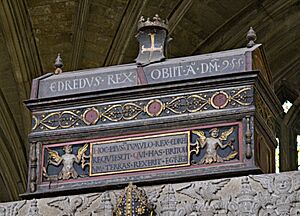
Illness and Death
Eadred suffered from poor health at the end of his life. This got worse and led to his early death. A writer from the 1000s described Eadred as "crippled in both feet." He never married, perhaps because of his poor health. He died in his early thirties on November 23, 955, in Frome, Somerset.
He was buried in the Old Minster, Winchester. However, this might not have been his first choice. In his will, he left gifts to an unnamed place where he wished his body to rest. Then he left property to the Old Minster, suggesting they were different places. His nephew Eadwig and the bishop of Winchester might have decided on the burial place. Some historians think Eadred wanted to be buried at Glastonbury. But Eadwig might have insisted on Winchester. This would prevent Eadred's supporters from using his grave to challenge the new king.
Eadred's Legacy
Eadred's main focus was on ruling England and getting back control of the whole country. Unlike his brothers, he did not play a big role in politics in other European countries. His main job was to make sure everyone accepted his authority. He spent a lot of time dealing with rebellions in the north. Northumbria had fought for its independence against many kings. But its acceptance of Erik Bloodaxe was its last attempt. It was finally conquered during Eadred's reign.
Historians have different ideas about how big Eadred's role was. Some think he relied on a small group of advisors to run the country. They believe he didn't have much direct power. Others believe Eadred was a capable and energetic king. They think he was held back by his poor health, which led to his early death.
Eadred's feelings towards his nephews are not clear. Some documents show both Eadwig and Edgar as princes. But others show Eadwig as prince and Edgar as his brother. When Eadwig became king, he removed Eadgifu from power and sent Dunstan away. This might have been an attempt to free himself from the powerful advisors of his father and uncle. But it didn't work. Within two years, Eadwig had to share the kingdom with Edgar. Edgar became King of the Mercians, while Eadwig kept Wessex. Eadwig died in 959 after ruling for only four years.
Images for kids
See also
 In Spanish: Edred para niños
In Spanish: Edred para niños


